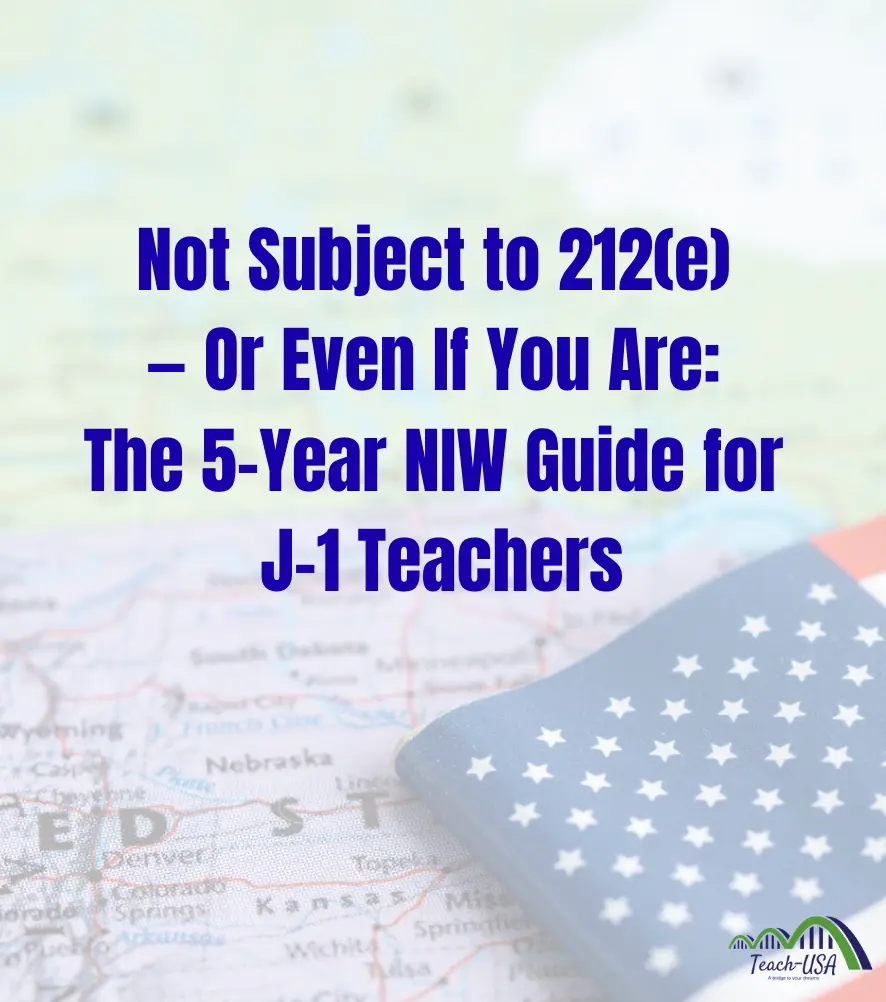So Your Visa Says “Not Subject to 212(e)”… What Does It Mean and What Can You Do Next in Your 5-Year J-1 Program?
If you’ve just checked your J-1 visa or DS-2019 and it says “Not Subject to 212(e)”, congratulations — you’ve just been given more options than many other J-1 teachers.
But what does this really mean? And how should you plan your next 5 years so you can stay, grow, and thrive in the U.S.?
Wait…
But what if you are subject to the 212(e) rule?
Then let’s start your NIW preparation too. Yes — you will still have to return home unless you have an approved waiver, but preparing early means you can file your NIW while in the U.S. and be ready to process your green card as soon as you meet the requirement or secure the waiver. Early planning can save you years of waiting later.
What Is the 212(e) Rule?
The 212(e) home residency requirement is a condition for many J-1 visa holders that forces them to return to their home country for two years before they can apply for certain U.S. visas or green cards. It often applies to:
- Those funded by their home government or U.S. government
- Those with skills listed on their home country’s “Skills List”
- Those in specialized programs
If your visa or DS-2019 is marked “Not Subject”, it means:
- You are NOT required to spend two years in your home country before applying for a green card or certain visa categories.
- You can apply for other visas or for permanent residency without first fulfilling the 2-year return requirement.
Why This Is a Big Deal
Being “Not Subject” gives you freedom and flexibility:
- You can switch from J-1 to H-1B, F-1, or another status without leaving the U.S.
- You can start your green card process without a 212(e) waiver.
- You can pursue the National Interest Waiver (NIW) while still in your J-1 program.
This means you can map out your career and immigration plan early — and avoid the panic many J-1 teachers face near the end of their program.
Your 5-Year J-1 Timeline: What to Do Next
Below is a recommended roadmap to help you maximize your time, secure your future, and make the most of your “Not Subject” status.
Year 1 – Get NIW-Ready from Year One
- Contact Teach-USA immediately for the NIW Preparation Guidelines so you know exactly what to document and collect from the start.
📧 Email: apply@teach-usa.net Use subject line: NIW - Learn what evidence you’ll need for your petition — from leadership roles to measurable student impact — and start keeping records now.
- Settle into your district: Learn school culture, curriculum, and expectations.
- Build your professional network: Connect with administrators, colleagues, and community leaders who could later provide strong recommendation letters.
Year 2 – Strengthen and Prepare with NIW Documentation
- Continue building your leadership profile
- Prepare your documentation — make sure you’re following the right process from start to finish.
- The Teach-USA NIW Toolkit walks you through evidence collection, letter requests, and petition preparation.
- Attend or present at conferences to strengthen your credentials.
- Volunteer for community outreach and keep all documentation organized.
Year 3 – NIW Filing Year
- Finalize your evidence portfolio (student achievement data, leadership proof, awards, publications).
- Gather strong letters of support from supervisors, district leaders, and community partners.
If you are Not Subject to 212(e):
- You can file your NIW now and proceed toward Adjustment of Status (I-485) if your priority date is current.
If you are Subject to 212(e):
- You can still file your NIW during your J-1 program. Once approved, you will complete your 2-year home residency requirement or obtain a waiver before continuing with your green card process. Filing now means you avoid starting from zero after going home.
Filing options:
- DIY Self-Filing through Teach-USA facilitation — includes step-by-step guidance, document review, and actual petition filing.
- Through a trusted attorney — full legal representation from start to finish.
Continue producing measurable impact in your school and community while your petition is in progress — this strengthens your case and credibility.
Year 4 – Follow Through While NIW Is Pending
- File your Form I-140 NIW petition (if you haven’t already) while still in the U.S. under J-1.
- Continue working in your J-1 program while your NIW is pending.
- If approved, you can:
- Transition to another visa (e.g., H-1B) if you need more time before your green card
- File for Adjustment of Status (Form I-485) if your priority date is current.
Year 5 – Secure Your Next Step
- If your NIW is approved, you can adjust status before your J-1 ends.
- If still pending, make sure you have:
- A backup visa option (H-1B, F-1, etc.)
- Your documentation ready for Adjustment of Status or consular processing.
- End your program strong — your professional reputation matters for recommendation letters.
Quick NIW Checklist
- High-need teaching field (Special Education, Math, Science, etc.)
- Measurable student and community impact
- Leadership roles and recognition
- Long-term plan to serve in the U.S.
- Strong documentation and recommendation letters
Bottom Line
If your J-1 visa says “Not Subject to 212(e)”, you have one of the most valuable advantages a J-1 teacher can get. But freedom without a plan can still lead to missed opportunities.
Use your 5 years wisely:
- Get NIW guidelines from Teach-USA right away
- Prepare with the NIW Toolkit early
- Choose the right filing option — DIY with guidance and filing support, or attorney-led
- File before the panic of your final year
The teachers who succeed are the ones who plan ahead, not scramble at the finish line.

